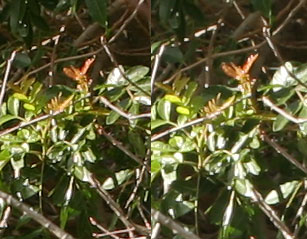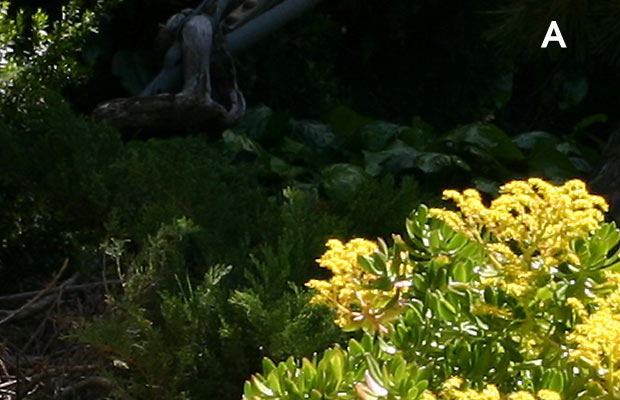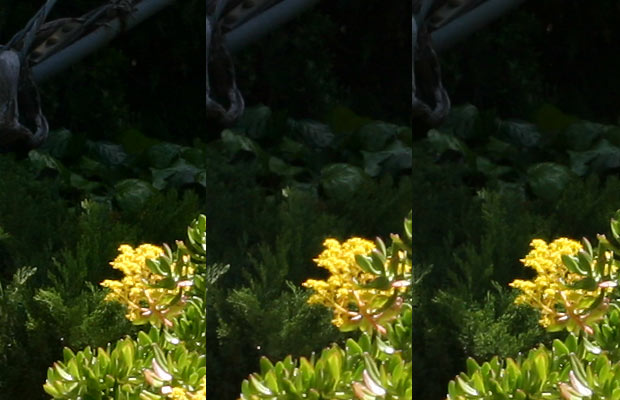|
Ideas to park in your photo-brain
3. Bigger
is Always Better
What do you
believe?
Who among us would actually
kid themselves? Not me, bro. I would never fool myself, given
the opportunity to encounter the real deal. And neither would
you.
 Except, of course, when we read specifications,
numbers, reviews and threads in Internet forums. Except, of course, when we read specifications,
numbers, reviews and threads in Internet forums.
Funny thing about beliefs.
We acquire them left and right without going to the trouble of
prodding them with a fork. Don't look a gift horse in the mouth!
When some outstanding authority says it's this way -- well, dad
gum if it isn't the gods' honest truth.
Such is the case of the curiously
expanding megabyte. Now that Canon has introduced the successor
to the 10D dSLR, many people are considering it as their next
camera, having decided that they're at the end of the road with
their basic Digital Rebel. Time to move on up!
Or is it?
Speed freqs
My Canon 20D is all metal.
My 300D is all plastic. At least on the outside where it counts.
Or does it count at all? Do sharper, better color balanced, better
exposed images drop out of metal bodied cameras?
My 20D shoots an 8.2 MP image,
but my 300D only collects a paltry 6.3 MP image. Obviously two
extra megabytes will make all the difference in the world, won't
it?
My 20D shoots long strings
of shots at five frames per second and my DR only collects four
images at 2.5 fps. Is that slow or what?
My 20D rips through its menu
and review system like it was on steroids. What's my Digital
Rebel's hang up?
My 20D doesn't have wireless
remote triggering capability. My DR does.
My 20D captures pictures that
take up more CF space than those inhaled by my 300D (same lens,
same tripod, same light, same subject, same focus, same ISO,
same WB, same compression), so obviously they contain more detail,
right?
Which of these are beliefs
and which of these are important deal-breaking bits of vital
intelligence?
Self-evidence
Some qualities are beyond
argument.
#1. The ability
to shoot a dozen images in 2.5 seconds is one of those things. If you like the near-movie like rapid
image gathering that the 20D brings you, then this becomes an
important, and perhaps deal-breaking, priority for you. But every
silver lining has its cloud, and the 20D's motor drive brings
several notions worth considering:
A. You can't shoot at LESS
than 5 fps with it in continuous mode (unless a long shutter
speed slows you down) and
B. Keeping the camera in continuous
frame mode--to let your finger do the choice on the fly--makes
for a very large number of two-shot bursts. It's quite a bit
harder to train your finger to let go of the shutter button
after a single shot. Of course, you will bless the camera when
shot #2 looks better than shot #1 and curse it when your CF card
seems to be filling up prematurely.
OK, B is minor, and I'd much
rather have too many images to choose from than too few.
#2. Fast running
camera computers are a blessing.
You'll get no argument from me on that. I like to pull my eye
away from the viewfinder eyepiece and see my shot playing back
to me instantly and the 20D does this about two full seconds
faster than the Digital Rebel.
And a One, and a Two...
I'm an impatient dude, so
this feels Important to me. It may not be a deal-breaker sort
of quality but it has its advantages when I'm moving fast.
#3. Remote
Possibilities. If you need
to wire your digital camera to a simple contact closure remote
or trigger it with a wireless button, those are things the DR
does well, and the 20D can only dream about. Of course, the 20D
can use Canon's cool wired TC-80N3 remote with built-in intervalometer
so this could be another dead heat in the race for features.
I take that back. After living with the TC-80N3 for a while I
must say this is a Killer Accessory, miles better than a simple
wired remote and it costs around $130, so if you have a 20D,
go out and get one, today.
#4. Eight
point two megapixels capture better images than 6.3 MP shots. Sure, that's the ticket. Or -- whoops,
what's this: (Roll your mouse over it to see a change.)

Two images shot through the
exact same lens within moments of each other. In fact, Canon's
50mm f/2.8 macro AF. Both are crops at 100%, meaning that the
display on your computer is one pixel of camera to one pixel
of computer image. Any blow-up from here would degrade the image
and any reduction would be casting out information.
You see shot A and shot B.
Which is "better?" It's only fair to tell you that
one of the images was made with the 20D's 8.2 MP CMOS imager
and the other one was made with the Digital Rebel's 6.3 MP CMOS
imager. Moreover, the larger 8.2 MP image was shrunk from
its native 3504 pixel width to 3072 pixels wide using Photoshop
CS' Bicubic Sharper scaling engine. Presumably the down-sampled
image plus the Bicubic Sharper interpolation would hold the larger
original to a micro-hair of perfection.
Three things
showed up:
1. One image is slightly smaller than the other, even
though Canon's published specification for the two CMOS image
chips is identical in size to the fraction of a millimeter. But
from the full frames, it's clear that one of these imagers is
collecting a tad more image than the other. About 1.5% more,
thus making that frame seem slightly smaller. That chip's width
captures a slightly wider view, so it had to be slightly physically
larger to intercept a wider portion of the image circle projected
by the lens. No big fizz, just an unexpected result.
2. One image looks microscopically less well defined
than the other. The sun was not its steady best between shots,
so small exposure-driven differences can be chalked up to test
conditions, but is that the difference between MP count, Photoshop
interpolation or chip performance?
3. Color and tonal handling differences between the
two shots is visible, but minor. Either could be tweaked in Photoshop
Elements, CS or virtually any editing program and be altered
to more closely resemble the other's color and tone. Yet right
out of the camera, the slightly sharper picture seems to have
the color and tonality edge.
But which is which? Write
your answer down on a piece of paper right now to preserve your
first impression. Your whole world depends on it. Don't try to
out-guess the process; just do it and read on...

You've probably seen this
image before. The inner blue rectangle is a 6.3 MP pixel field
and the outer pink rectangle is an 8.2 MP array of pixels graphically
comparing the 300D to the 20D field of photosites. Obviously
the pink one can capture more details than the blue one. Right?
Are you positive? Final answer?
Conclusions
When you apply a string of
logical comparisons to any idea, you can turn the logic crank
and new ideas pop out the other side. Aristotle taught this thousands
of years ago, and in spite of his best efforts, digital photography
took all this time to evolve, idea by idea, point by point, up
to images of today's quality. Canon has diligently been trying
to catch up. It's encouraging.
Presumably, a two-year newer
design of CMOS image chip would do a better job of defining detail,
preserving color and tonality and operating faster. Certainly
the 20D is much faster in its capture -> write and review
processes. (Phil Askey's excellent comparative noise level charts
at DPReview.com
show that the 20D makes a significantly less noisy image than
anything out there at the highest ISOs, and that's a big plus.)
Being in hot competition with
other manufacturers doesn't hurt, either. We who buy these things
are always ready to jump toward the next greatest thing at the
drop of a new product announcement. We--The Market--want it all,
and we're very demanding. "More, better, faster, cheaper!"
we shout, repeating as needed.
In the evolution of features,
hardware, software, computers and more advanced model cameras,
we expect More at every step, and when the specs say More is
available, we get all warm and fuzzy inside. What-has-been-promised
now equals what-we-want-to-believe, so all's right with the world.
So you and I would never intentionally
fool ourselves, eh? And we would never put our faith in something
just because someone with an agenda all their own said something
to us, right? What is it people say about the percentage of things
you can trust in newspapers? How does that translate into advertising?
No matter what your level
of cynicism, you have to trust something, somewhere, sometime,
right? Or are we at the mercy of our beliefs? All this chat about
the concepts of belief, trust, truth and photography seems scattered,
but when you read the paragraph after next, you may end up smacking
yourself in the head again. It's a theme that runs through these
Advanced Concepts articles.
Besides, I had to write several
paragraphs here so you couldn't just scan down the Internet page
and read the exciting conclusion to our test.
A:
The microscopically lower
quality image in the rollover example above (B) is from the 8.2
MP Canon 20D. The slightly higher quality image (A) is from a
Digital Rebel that is selling for just about exactly half of
the price of the 20D body. Its tiny edge of detail is only part
of the story. Tonality and color seem better, too, eh? So much
for believing that 8 MP trumps 6 MP. If you ask me, and I realize
you didn't, it's a virtual dead heat in the image quality department.
By the way, both cameras were
firmly affixed to a tripod for this test. No fair thinking that
some sort of extraneous camera-handling factor has degraded the
8.2 MP image. If you form a thought like that, it could be the
irresistible pull of self-delusion trying to re-establish its
priorities among your little gray cells.
Read the more thorough reviews
from Imaging
Resource and DP
Review to gain a more in-depth insight under a wider variety
of conditions.
From the test charts seen
in these reviews, one notes that the 20D does about 10/9ths as
well as the 300D Digital Rebel. Meaning that under laboratory
conditions, the 14.1% larger imager delivers about 8.8% more
actual fine detail. How do we know that? It seems that finely
scribed black and white lines on a sheet of paper show it that
way. The 20D portrays 2000+ image lines in this sort of test
where the 300D tends to peak out around 1850.
Real world experience suggests
that the actual performance between the two imagers and processing
is substantially moot. It's so close between them that
I have no hesitation at all to use the camera that is handiest
for any given situation. If the lens I want to shoot with next
happens to be on the DR, it's not worth the dust-risk to swap
lenses in order to convince myself that the big --woo hoo-- 8
MP image is just what is vital right now.
Of course, as of March, 2005,
this whole page may be moot. The Rebel XT uses the exact same
image chip as the 20D but masks it down to 48 x 32 fewer image
pixels. We think that was done for Bragging Rights marketing
purposes, but they may have had some underlying technical reason
(yeah, right) to deliver the microscopically smaller image. At
any rate, the Rebel XT is a killer camera by any measure and
pixel for pixel matches the image quality of the original Rebel,
while delivering more of them. That makes handy crops easier
to deal with.
Bottom Line:
The 300D is now a $700 camera
with the Kit Lens. The 350D is now an $850 camera with the Kit
Lens. The 20D is now a $1250 camera with a Kit Lens and the handling
qualities, ergonomics, speed of operation, options and features
of these cameras is closely reflected in their current prices.
Who Needs
What?
- For 20D owners--relax. You
have a faster, more ergonomic camera with higher ISO images that
show very low noise. If you are a pro who needs a second camera
body, don't hesitate to buy a 350D in its black body option.
- For 300D owners--relax. Your
pictures are within a smidgen of the image quality a 20D will
give you. Unless you need the extra fast operation and 5 fps
motor drive, just keep that 300D banging away, collecting excellent
images. You owe it to your sense of Right and Truth to check
out the 350D.
- If you are a 10D owner--relax.
The upgrade cost to a 20D will set you back around $800 (including
recycling your 10D on eBay if you are lucky) and the main reward
is a faster operating camera with fewer delays in startup, review
and write speed. Some 10D photographers I know are thinking of
getting the 20D as their #1 cam shuffling their older 10D as
their #2 body, and that's a strategy that makes complete sense.
Perhaps you should check into the 350D. Not as fast in some ways,
but way faster in others.
- If you are a Nikon D70 owner--relax.
Your camera has a slight edge on the 20D in ergonomic and operational
aspects that you don't need to get bent out of shape over. Your
D70+Kit Lens used is worth maybe $700 today (used or trade-in)
and the 20D with 17-85 IS lens will cost you +$1,300 over that.
Some future camera may fit your needs better. No sense in recycling
all your optics.
About the
Test
 As noted earlier, there has been a small
adjustment from the 8.2 MP image: It was reduced to 3072 pixels
wide, a loss of 432 pixels, about 12.3% smaller, in order to
superimpose over the DR image. As noted earlier, there has been a small
adjustment from the 8.2 MP image: It was reduced to 3072 pixels
wide, a loss of 432 pixels, about 12.3% smaller, in order to
superimpose over the DR image.
Transformations of this sort
can be responsible for small degrees of image degradation, even
though we have used Photoshop's Bicubic Sharpen option to preserve
as much detail as is possible.
When the two images are cropped
side by side, the smaller DR image is easy to spot, but are the
pixels of the 20D doing as well with every little dot of color?
You decide.
I plan to do more testing
with the two shooting through the same lenses. I'll report back
here when I find out new things.
My theory is that many people
buy the 20D not for its speed and continuous frame capabilities--they
buy it for that big, honking 8.2 MP image that will take them
to places no mere 6.3 MP image could ever handle. The big winner
here is the marketing department. In my macro lens at an optimum
f-stop of f/9, they are virtually equivalent at best. Advantage:
DR. But only due to its price.
Of course, by not doing this
test with your own hands, aren't you taking some third party's
word for it again?
-iNova (January, 2005)
Addendum:
Once again (April, 2005) we
have tested the image differences between the 20D and 300D cameras.
This time we were comparing the per-pixel resolution of the newer
EOS 350D Digital Rebel XT to the 20D's chip coverage with the
300D thrown in for comparison.
Here's the test: A, B and
C images are presented. This time, all were scaled to the same
pixel count. Since the 20D image is largest in pixels, but only
98.9% of the physical dimensions of the 300D image, the 300D
shot was scaled up to 101.1122346% (the reciprocal of 98.9% or
3543 pixels wide) in order for the actual subject detail to drop
on top of the larger frame. The 350D image was simply dropped
intact on top of the 20D image and since pixel sizes are identical,
no subject size difference is seen at all.

Results are interesting. In
the first test, we down-sampled the larger 20D frame to mate
with the unchanged 300D image. The theory being that down-sampling
operations at this scale would not harm the 20D image much at
all, and from the later 1:1 comparison (About the Test, above)
we saw a consistent slightly lower detail level in the 20D image.
A=300D (straight), B=350D
(rollover) and C=20D (click/hold). All images are crops showing
the final 1:1 pixels on your computer screen.
The new test was made at f/10
and several freshly auto-focused frames were made of the subject
to both increase DOF and avoid any missed focus variables. Indeed,
all three cameras delivered very sharp images. You could blow
any of the frames up to 12 x 18 on a Canon i9900 printer and
nobody could tell them apart other than from slight differences
of color. Even the manual exposures (ISO 100 - 1/100sec - Daylight
WB - f/10 - Parameter 1) produced results that look like nearly
sequential exposures from a single camera.
But this time, the ever so
slight edge goes to the 8MP cameras, and if push came to shove,
the 20D has the slimmest of advantages over the 350D. It shows
up not as greater resolution or finer detail but as a tiny bit
tighter control of the red channel. It's really the sort of thing
you can only see under a 200% blow up when flipping back and
forth between images of subjects that have bright red, orange
or yellow colors in high contrast contours. The 300D shows the
same micro plus in its red channel as the 20D.
Any small level scaling of
an image can compromise high-frequency detail (fine textures,
sharp contours, small line detail) and that holds true when scaling
up or down. That's what made the 20D image look microscopically
lower in resolution than the 300D image. When a reciprocal enlargement
is applied to a 300D image, the reverse shows up and the 300D
image now looks slightly less detailed than the 20D/350D frame.
When small image scaling occurs,
it's prudent to add sub-pixel unsharp masking to the image to
help make up from the low-level pixel compromises. In the blown-up
300D image, a small (30% of one pixel at 100% influence) Unsharp
Mask tweak was added, not to mess with your mind, but to refine
the image the way it would be in any practical use. I typically
add this degree of small refinement to images that are manipulated
in the ±10% scale range. Here, the technique brings the
300D image up to 20D/350D level in natural images like this.
If you performed the same adjustment to an image of a test chart,
it would not produce the higher definition of the larger chips.
Where our first test involved
slinging pixels around, the second comparison sees them at actual
size. Here are all three side by side (300D, 350D, 20D) without
any scaling or Unsharp Masking involved:

So what do we know now that
we didn't know before? Probably these:
1. Canon makes great pixels
and you can't go wrong with any of these three cameras.
2. They had nailed down virtually
all the top attributes of image quality before the 300D was introduced
and haven't skimped on per-pixel detail even though you get more
of them for your camera dollar in the current models.
3. Your own verification of
ideas like this will still mean more to you than taking my--or
anybody else's--word for it.
-iNova (April 2005)
Get the eBooks
 For
your Canon Digital Rebel- DSLR: Canon Digital Rebel EOS 300D
eBook is already on the shelf. DSLR: Canon Digital Rebel XT is
next. Then DSLR: Canon 20D follows. These are great cameras with
a great deal inside them, so we put a great deal of information
into their eBooks. You'll find things here that nobody else ever
told you about and not even Canon knew or could discuss. For
your Canon Digital Rebel- DSLR: Canon Digital Rebel EOS 300D
eBook is already on the shelf. DSLR: Canon Digital Rebel XT is
next. Then DSLR: Canon 20D follows. These are great cameras with
a great deal inside them, so we put a great deal of information
into their eBooks. You'll find things here that nobody else ever
told you about and not even Canon knew or could discuss.
The existing
iNova eBooks, DSLR: Nikon D70 has become the most popular premium
eBook of all time. Mastering Nikon Compact Digital Cameras and
The SONY Advanced Cyber-shot eBook are also available. Click
on the image for the appropriate order page.
|




 Except, of course, when we read specifications,
numbers, reviews and threads in Internet forums.
Except, of course, when we read specifications,
numbers, reviews and threads in Internet forums.
 As noted earlier, there has been a small
adjustment from the 8.2 MP image: It was reduced to 3072 pixels
wide, a loss of 432 pixels, about 12.3% smaller, in order to
superimpose over the DR image.
As noted earlier, there has been a small
adjustment from the 8.2 MP image: It was reduced to 3072 pixels
wide, a loss of 432 pixels, about 12.3% smaller, in order to
superimpose over the DR image. For
your Canon Digital Rebel- DSLR: Canon Digital Rebel EOS 300D
eBook is already on the shelf. DSLR: Canon Digital Rebel XT is
next. Then DSLR: Canon 20D follows. These are great cameras with
a great deal inside them, so we put a great deal of information
into their eBooks. You'll find things here that nobody else ever
told you about and not even Canon knew or could discuss.
For
your Canon Digital Rebel- DSLR: Canon Digital Rebel EOS 300D
eBook is already on the shelf. DSLR: Canon Digital Rebel XT is
next. Then DSLR: Canon 20D follows. These are great cameras with
a great deal inside them, so we put a great deal of information
into their eBooks. You'll find things here that nobody else ever
told you about and not even Canon knew or could discuss.